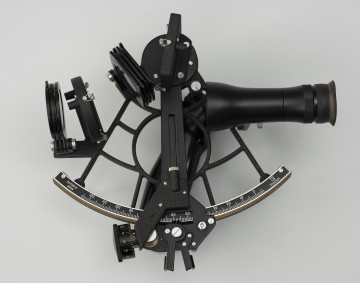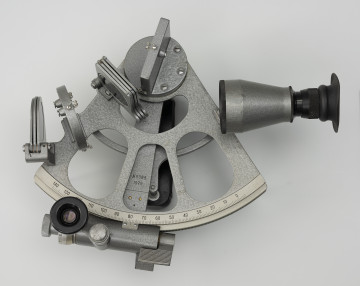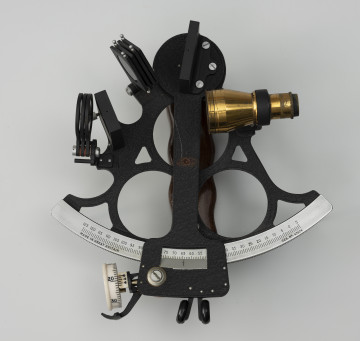
Tamaya Jupiter sextant
1983-02-28
National Museum in Szczecin
Part of the collection: Navigation history
Invented by John Hadley (1682-1744), a British mathematician and inventor in 1731, the sextant remains essentially unchanged in its design to this day. This navigational instrument of a rather complex nature is used to measure the angular distance between two observable points. Its primary task in astronavigation is to measure the angle between the observed celestial body and the horizon, which, together with the time of measurement, is used to determine position lines on nautical and aeronautical charts. A sextant can be used to measure the height of a landmark and, based on this information, determine its own distance from it. In the horizontal position, the sextant also serves to determine the angles between objects located on charts, and the combination of the angles between at least three such points will determine the ship's position relative to these points. The featured instrument is a product of the Japanese company Tamaya Technics Inc, which traces its origins back to the 17th century when Tozaemon Tamaya began selling lenses and spectacles under the Tamaya Megane-ten banner in 1675. In the early 20th century, it became the first company in Japan to import foreign optical surveying equipment. It operated under the name Tamaya Shōten at the time. Soon it began selling products under its own-brand such as optical length measuring devices and pocket compasses. After 1912, Tamaya was already producing its own theodolites and, the first domestic sextants in Japan, starting in 1922. Throughout much of the 20th century, the company was divided into two units, one producing military equipment and the other supplying the civilian market. To this day, Tamaya specialises in surveying, measuring, navigation and drafting equipment, as well as meteorological and other optical instruments. It has been operating under its current name since 1983.
Author / creator
Object type
sextant, box
Technique
batch production
Material
metal, brass, plastic, glass, mirror
Origin / acquisition method
purchase
Creation time / dating
Creation / finding place
Owner
Muzeum Narodowe Szczecin
Identification number
Location / status

1983-02-28
National Museum in Szczecin

circa 1976
National Museum in Szczecin

1951 — 1975
National Museum in Szczecin
DISCOVER this TOPIC
Museum of King Jan III's Palace at Wilanów
DISCOVER this PATH
Educational path